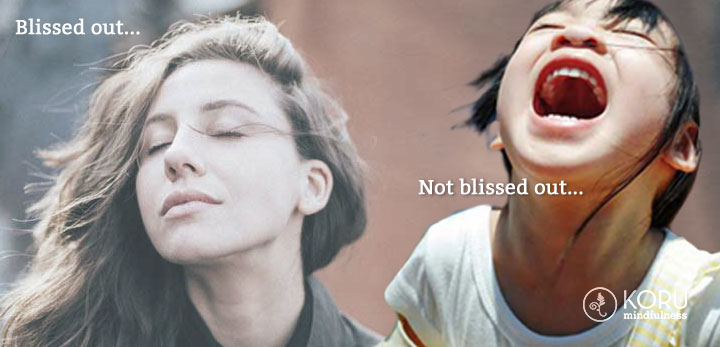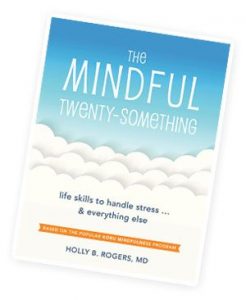
Getting started with a meditation practice can be tricky. I remember clearly the first time I tried to meditate. It wasn’t the blissful experience you’d expect from looking at pictures like this:

Instead, it was more like this:

What Got Me Going?
I was at a time in my life that had a lot of uncertainty and change, typical triggers for creating anxiety and stress. And thus, I was feeling anxious and stressed.
In that mind set, I stumbled upon a book called “Mindfulness in Plain English.” I picked it up to examine it more closely thinking, “What does that mean? It seems to already be in plain English.”
I’d never heard of “mindfulness” and wasn’t sure what it was.
I sat down with the book and read the whole thing. The concepts in it were entirely new to me.
The author, Henepola Gunaratana, explained that by practicing meditation I could learn to relate to the circumstances of my life differently, and thus feel much less anxiety and stress.
He said this would happen even if nothing else in my life changed.
That blew my mind.

He was very convincing, but he said I shouldn’t just believe him. I should try it and see. So I did.
A Discouraging Start
I went home, pulled the pillows from my bed onto the floor, and sat on them in a very convincing meditation pose, just like I’d seen in the movies. Following Gunaratana’s advice, I began to watch the flow of my breath.
Within second’s my mind was spinning away from my breath, filled with opinions and assessments.
(This is really cool, I’m meditating. I can’t really feel my breath that well. I’m not really enjoying this. This is boring. Probably be better to just take a nap.)
Within minutes, my body was really restless.

(Actually it’s pretty uncomfortable sitting on these pillows. I wonder how long it has been. I don’t think I can sit here much longer. I’ll just look at the clock. It’s only been 5 minutes. This is killing me.)
So, I didn’t feel much of the relief I was hoping for after that first attempt.
Persisting
I can’t really say why, but for some reason I didn’t give up on meditation, even though it wasn’t am immediate cure-all. Some part of me recognized that this was the real deal, and if I persisted, I would get the relief I was seeking.
I knew I needed help, so I called a former mentor of mine, Jeff Brantley. I knew that Jeff had something to do with meditation. I asked him if he had ever heard of mindfulness meditation. He laughed and said he’d been practicing it for years. Lucky for me, he agreed to meet with me regularly to get me started.
Jeff also gave me the best advice about building a mediation practice. He told me that I would not stick with it if I didn’t join a regular meditation group.
I followed Jeff’s advice (even though I am usually quite a stubborn know-it-all and don’t follow good advice) and joined a sangha (a meditation community) that practiced meditation together every Wednesday night.
I sat with that group almost every week for 20 years; I am certain that without them I never would have persisted.
With the group’s support, I developed a daily practice and started attending mindfulness meditation retreats. It was not long before I was hooked, because I could tell that I was happier, less worried, and kinder to myself and others.
4 Simple Steps to Get You Meditating
So what about you? Do you feel stressed, unhappy or unsatisfied in your life? If so, you have nothing to lose, and perhaps a great deal to gain, by giving mindfulness a chance. Here are 4 steps to follow if you want to truly give it a try.
Step One: Practice
You can’t learn mindfulness just by reading about it. You have to practice. And the way you practice mindfulness is with meditation.
So, just do it. Sit down right now, close your eyes and count ten breaths. When your mind wanders, just bring it back to your breath, without criticizing yourself or your wandering mind.
That’s about a minute of meditation. Do that nine more times and you will have made a very good start.
It’s that simple. Do it every day.
Step Two: Get some help
It is really, really hard to make progress by yourself. The most reliable way to get started is to find a teacher or join a class. Koru is a great 4 week class that is the perfect introduction to mindfulness. See if there is a Koru Mindfulness teacher near you and sign up for a class.
Live classes or groups are best, but if you can’t find one, try an online course, like the popular Headspace.
Step Three: Commit
Commit to sticking with it for at least 4 weeks, ten minutes a day. This will give you an actual experience of how it works and how it helps. Then you can decide if you want to persist. There are lots of meditation apps out there that will help you with this. Try the free Koru Mindfulness app with a timer and guided meditations.
Step Four: Retreat
At the end of the four weeks, if you are ready to step it up a bit, put a weekend or longer mindfulness meditation retreat on your calendar.
Now, don’t just dismiss step #4 and keep reading. Pause and think about this for a sec.
You are not alone if your first reaction to this suggestion is that it sounds kooky, and maybe a bit miserable. Most people feel that way at first. I know I did. I told myself I would never be able to do that.
But I was wrong, as I am about so many things. Over the years I’ve done many retreats and have found them to be transformative.
In a retreat you have the chance to dive in and experience the full benefits of a mindfulness meditation practice in an entirely different way. By the end of the retreat, you’ll feel like an expert.
Consult the oracle, Ms Google, and search for “mindfulness”, “insight”, or “vipassana” meditation retreats in your area. A number of places have retreats just for young adults; check out IMS, iBme, and Spirit Rock.
So there you go. A four step plan for launching a truly transformative meditation practice. Give it a try, and see if like me, you find your life is transformed for the better.
Already a meditator and have some wisdom to share? Other thoughts about a beginning mindfulness practice? Share your thoughts below.

Be kind to yourself. Don’t be upset if focus occasionally drifts of if you fall asleep. If very tired, meditate with eyes open and rearrange posture to more erect (but still relaxed) position.